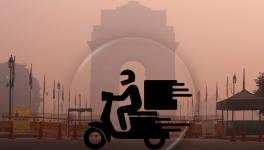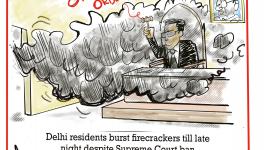New Vehicle Scrappage Policy: Burden on Consumers, Free Pass for Auto Industry
Image Source: The Indian Express
The Union Budget presented in Parliament on February 1, 2021 announced a long-promised and much-awaited vehicle scrappage policy. Subsequently, the Minister for Road Transport & Highways (MoRTH) provided some additional details, although the final policy document was not made available in the public domain on or after February 15, as he promised. Nevertheless, sufficient information is now available to enable at least a preliminary assessment of this policy.
A large number of countries, mostly in North America, the European Union, Japan, Australia etc., have vehicle scrapping policies, many of them going back more than 10 years. Most such policies cite two major objectives: First, retiring older, more polluting vehicles to reduce air pollution and emissions, and second, stimulating the automobile industry.
These policies gained serious traction during and after the global economic recession of 2008, highlighting the latter aspect, linked with incentives for replacement with newer vehicles. Some countries have emphasised replacement by less polluting or more fuel-efficient vehicles.
Likewise, in India, the automobile industry has witnessed a slump over the past three years, exacerbated by the COVID-19 pandemic, and was down by 24%, as of 2020-end. This sector, therefore, has been increasing pressure on the government to introduce a scrappage policy. The heavy and commercial vehicle (HCV) segment is down by over 50% and will hugely benefit from such a policy, but faces heavy headwinds from HCV users.
In India, a vehicle scrapping policy has been discussed in government circles in one form or another for close to a decade, but never fructified due to conflicting or at least divergent views and interests between different stakeholders, such as the automotive industry, personal vehicle and truck owners, and different departments of the government. Many of those divergent interests remain even today with the new policy.
Truck owners are particularly upset, as they foresee substantial losses and new investments beyond their means.
The impact on air pollution and the environment is often simply assumed, since older vehicles are being replaced by newer ones. But how much are the environmental gains and to what extent do policy provisions push for lower pollution? Since the general public, particularly lower-income groups, which are usually more exposed to polluted air, are the main victims of vehicular pollution, should they not also be counted among the key stakeholders?
Automobile manufacturers are, of course, the happiest, anticipating a boom in demand. Vehicle scrappage policies are usually hailed as a win-win. This article asks, however, do some stakeholders win more than others?
The Policy
Under the new policy, personal vehicles that reach 20 years of age and commercial vehicles at 15 years, will compulsorily have to undergo a fitness test in automated centres that would look at “international standard” parameters of tailpipe emissions, safety measures, braking systems, body integrity etc., supposedly drawing upon the criteria applied in Europe, Japan etc. Vehicles that clear the fitness test are entitled to re-register, but it is likely that registration renewal may be made expensive so as to persuade vehicle owners to avail of scrapping incentives instead and buy a new vehicle. Vehicles that do not pass the fitness test will have to be scrapped.
Further clarity is awaited from the detailed policy document. The first set of scrappage policies in Europe and elsewhere provide for one-time scrapping of old vehicles. In India, the policy appears to be perpetual, or at least till it is viewed as necessary. In other words, each year a batch of vehicles would be scrapped on reaching the specified age limit.
The policy is slated to come into effect on April 1, 2022 for vehicles owned by government and public sector undertakings (PSUs) which will scrap all vehicles more than 15 years old. A year later, in 2023, all heavy commercial vehicles will undergo mandatory fitness tests, while the policy will kick-in in June 2024 for personal and all other classes of vehicles.
The policy provides for a range of incentives for vehicle owners to opt for scrapping rather than re-registration. A reduced GST (goods and services tax) of 5% or even a complete GST waiver on new replacement commercial vehicles is proposed, instead of the 28% GST on commercial vehicles and those carrying 10 or more persons.
The policy proposes that those opting for scrapping would get scrap value at the scrapping centre, which has been pegged at around 4-6% of the showroom price of new vehicles, and will also get a road tax rebate of up to 25% on personal vehicles and 15% on commercial vehicles. A 5% manufacturer’s discount against the scrapping certificate and a waiver of registration fee are also suggested.
However, it is to be noted that all these incentives are only recommendations and would need to be accepted or modified by state governments for whom these taxes are major sources of revenue, by the GST Council, and importantly, also by manufacturers who may well be reluctant to offer the discounts suggested. It would have been far better if these stakeholders had been consulted and these tax breaks and manufacturers’ discounts had been firmed up before.
As things stand, therefore, there is a great deal of uncertainty about incentives, therefore, about how many vehicle owners will actually opt for scrapping, and how many old, polluting vehicles will end up being taken off the roads. This uncertainty does not bode well for the pollution reduction goals of the policy.
Vehicle manufacturers stand to gain the most from the suggested rather than mandated manufacturers’ discount. A discounted price on new vehicles, whether provided by the government or the manufacturer or both, has been the cornerstone of the scrappage policies in Europe and main incentive for owners. The absence of a Centrally-budgeted cash incentive to supplement a mandatory manufacturer’s discount linked to scrappage is the weakest element of the new policy. Without certainty of such discounts, the scrappage policy would encourage vehicle owners to opt for re-registration of older vehicles rather than purchase of newer less polluting ones.
The Delhi Government’s policy for incentivising purchase of battery-operated vehicles, for instance, not only has a cash subsidy based on battery capacity, but adds a scrappage-linked cash incentive as well.
As things stand, the Central government has abdicated its responsibility, vehicle manufacturers have been given a free pass, and the burden has been thrown on the consumer who will feel aggrieved and disincentivised and on already cash-strapped stage governments, while the interests of the citizen in reduction of air pollution has been sacrificed.
Cutting Pollution
A reduction in pollution from old, fuel-inefficient vehicles is the very raison d’etre of the scrappage policy. Yet, the government has failed to prioritise or give due weightage to this goal.
It has been estimated that around 51 lakh light vehicles in India are over 20 years old, out of which 34 lakh are over 15 years old. Earlier versions of this policy implemented in Delhi and other metros had placed “end of life” of personal vehicles at 15 years with no option for re-registration, which was made cumbersome, resulting in such vehicles being sold to out-of-state parties in smaller towns and cities. The shift from 15 to 20 years, without any cut-off definition of end-of-life beyond which no re-registration would be permitted, will itself allow more polluting vehicles to operate.
Older vehicles cause more pollution due to lower engine efficiency, higher fuel consumption and lower quality of fuel used, with many old vehicles designed for operation with BS-1 or BS-2 fuel compared with the contemporary BS-6 fuel. Some estimates suggest that if all vehicles over 20 years old are replaced with new BS-6 standard vehicles, vehicular air pollution could be reduced by 25-30%. While older vehicles are a relatively small proportion of the total number, their contribution to pollution is extremely high.
MoRTH estimates that commercial vehicles are only 5% of the total, they contribute 65-70% of vehicular pollution, with vehicles made before 2020 accounting for 15% of total vehicular pollution. A 2014 study by IIT-Bombay estimated that pre-2005 vehicles were responsible for 70% of total pollution load from vehicles. Some experts have pointed out that old trucks designed to BS-1 standard, emit 36 times more particulate pollutants than BS-6 vehicles.
However, the new policy fails badly in properly targeting the most polluting classes of vehicles, and in providing adequate linkage of scrapping with internal combustion engines with greater fuel-efficiency or, even better, with electric vehicles (EV) or, later when they enter the market in a big way, with hydrogen-based fuel cell vehicles.
Similar targeted incentives for personal vehicles would also have contributed in a big way to reducing pollution. For example, graded cash incentives by government and manufacturers could be indexed to fuel-efficiency of the replacement vehicle being purchased. The highest cash incentives could be offered for switching over to hybrids or full EVs, with maximum discount for the latter. Such a system would not only bring about greater reduction of pollution, but also provide a major fillip to EV introduction.
The experience in Germany, with the most forceful scrappage policy linked to government incentives as part of a stimulus package for the automobile industry, suggested that pollution reduction was not that high in replacement of one internal combustion-based vehicle with another. This was partly because the older vehicles were not so much less polluting or fuel-efficient as newer vehicles due to earlier and stronger standards, unlike in India. Some gains were made, as car sales figures showed, because owners of older large luxury vehicles tended not to replace them with new equivalent models, but opted for smaller more fuel-efficient makes due to a changing environment-friendly culture.
Vehicle Scrapping
Finally, on the actual scrapping itself. According to the policy, clusters of scrapping centres compliant with international standards would be set up in public-private partnership or PPP mode all over the country, especially near ports, with some incentives from government. This is expected to reduce pollution from unorganised scrapping and enable far greater recovery of reusable or recyclable materials from scrapped vehicles, especially steel, rubber and plastics, and also facilitate more environmentally sound recovery of e-wastes, heavy metals etc.
It appears that government expects these scrapyards to also undertake scrapping of imported end-of-life vehicles. Given the horrible experience in the Alang and other ship-breaking yards in the country, strict and rigour monitoring of the practices and environmental standards at these scrapyards is called for.
Fortunately, an Automotive Industrial Standard AIS-129 is already in place in India since 2015, governing reuse, recycling and material recovery from vehicles. AIS-129, modeled on EU standards, requires that 80-85% by weight of material used in vehicles should be such as would enable recovery, reuse or recycling at the end-of-life of the vehicle.
However, implementation and proper monitoring and regulation would be key, which has always been the proverbial Achilles’ heel in India’s policy-making. The environment, especially with regard to contamination of soil and ground water, should not become a victim of the scrapping policy.
All in all, while not unacceptable in principle, the new scrappage policy is poorly designed to achieve its own stated goals of reducing pollution, and is heavily weighted in favour of the automobile industry.
Get the latest reports & analysis with people's perspective on Protests, movements & deep analytical videos, discussions of the current affairs in your Telegram app. Subscribe to NewsClick's Telegram channel & get Real-Time updates on stories, as they get published on our website.
























